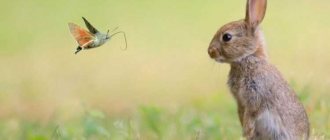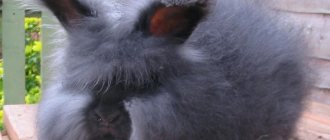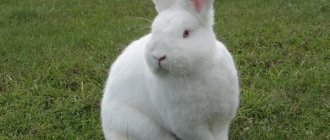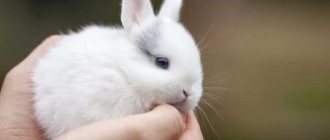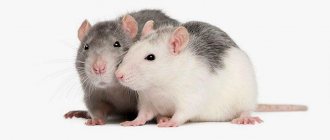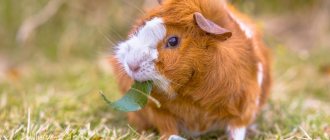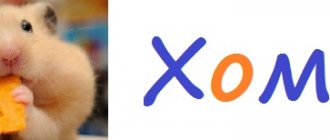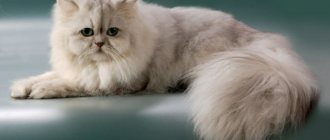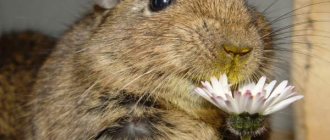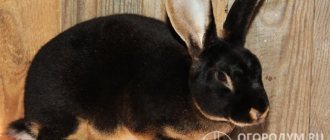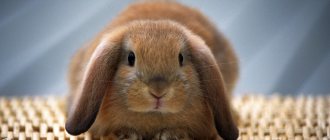Sizes of dwarf rabbits
I am often asked about the size of dwarf rabbits, some are afraid that they will be very large, like meat rabbits, and others want an adult palm-sized rabbit, so I decided to make a brief overview of the parameters of different breeds of rabbits.
WILL THEY NOT GROW LIKE MEAT PETS?
As we can see in the photo above, even the largest dwarf rabbits will never approach the size of meat breeds. The maximum weight of a lop-eared rabbit is 2 kg, while meat rabbits weigh 5 kg or more, that is, their meat counterpart is at least 2-3 times more. So, we should not forget about the character of the animals, the selection of dwarfs is carried out not only by size, but also by the character of the animals, they must be kind to humans and not have bad habits. While meat rabbits are selected only for productive qualities and good manners, this is not a prerequisite for admission to breeding.
The photo shows the largest of the decorative rabbits, adult lop-eared rabbits weighing up to 2 kg, so you can estimate their size.
WE WANT A RABBIT THE SIZE OF THE PALM
It all depends on the size of your palm)) But seriously, there are no adult dwarf rabbits the size of a hamster; babies can be this size, for example minors. At 1.5 months they weigh about 300-400 grams, the size of half a palm.
minor, age 1.5 months
Adult animals weigh about 1 kg and measure about 20-25 cm, which is just the size of the palm of an adult man or slightly longer than the length of a ballpoint pen. But we must take into account that such a small animal requires more careful care and maintenance, as it is easy for them to cause various injuries through negligence.
Adult Minor rabbits are next to a ruler and other objects so that they can estimate the size of this breed.
Source
Reproduction
If you have already purchased a purebred individual, you can use it for breeding - this is useful for the animal itself, and allows you to give a fluffy bundle of happiness to your loved ones, and leaves opportunities for good earnings.
Female rabbits become ready to mate early - it is usually recommended to mate them for the first time even before the animal is one year old. It is quite easy to determine that the animal is ready and needs the company of the opposite sex, since the pet’s behavior changes radically - now the female behaves restlessly and is easily irritated. If you have at least once observed the life of rabbits, then you know that they do not need much time to mate - once they are mutually accessible, they almost immediately get down to business. The animals are left alone for a short time, after which they are seated, but the procedure is repeated the next day - this must be done just in case, so that the rabbit definitely becomes pregnant.
The duration of pregnancy in dwarf rabbits depends on various factors, but usually it is exactly one month. At the same time, a large number of cubs usually leads to a fairly early birth, but a small litter, even consisting of fairly large babies, is often slightly delayed.
Caring for a pregnant female is somewhat different - you need to approach the principles of menu formation differently. If in the first two weeks of pregnancy no noticeable differences are observed, then by the third week the rabbits growing in the womb require more and more calories, so the dosage is increased slightly. At the same time, it is undesirable to overfeed a rabbit, because these animals are prone to gaining excess weight, which ultimately leads to health problems. At the same time, it is worth slightly increasing the dosage of cucumbers, as well as some other vegetables and fruits, since, according to some experts, they have a beneficial effect on milk production.
Newborn babies do not hear or see anything, they are strictly forbidden to be separated from their mother - at this stage, only she herself can fully care for them. The person’s task now is to provide a warm place, since even just on the bare floor the babies will die, and to increase the diet for the rabbit.
The behavior of a mother rabbit may seem strange to inexperienced people. First of all, such a mother does not sit around her cubs, but there is nothing unusual in this - even in nature, she would leave them in the hole, while she herself went to look for food for herself in order to produce milk. Despite the fact that you feed the animal and it no longer needs to search for food, the instinct does not go away, so the female only visits the babies indoors, otherwise trusting their will of fate.
At the same time, the owners must closely monitor that the rabbit never remains hungry. The fact is that this peaceful herbivore, being hungry, can easily eat its own cubs!
Sizes: furry giants and babies
During selection, two hundred breeds of animals were bred, and they all differ not only in characteristic habits, color and length of fur, but above all in weight and size.
Breeding standards
The range of values is so wide that all domestic rodents are classified into four main groups:
Eared giants
Among some breeds, animals of truly outstanding size stand out:
But the real giants are the rodents bred by Soviet breeders in the middle of the last century. Combining the desire to obtain animals with high vitality, precocity and excellent health, scientists crossed the English breed of large animals with local ones, which were distinguished by their large body weight. Thus, scientists obtained giant rabbits with good genetic characteristics:
The leading place in terms of size is occupied by the Belgian Flanders. A long rabbit, growing up to 70 cm, with thick, luxurious fur. Ordinary animals weigh from 7 kg, some grow up to 10-12 kg, and the recorded record is 25 kg.
How old do dwarf rabbits grow?
Babies gain weight quickly. A healthy female of a dwarf and small breed, subject to calm gestation and the absence of diseases, gives birth to rabbits with an average weight of 70 grams. Doubling occurs 6-8 days after birth and increases fivefold by two weeks.
By the month of life, the initial mass of the baby rabbit exceeds 10-12 times. The main body growth and density gain occurs up to 3-4 months and is 80% comparable to the weight of an adult animal. A distinctive feature of animals is their rapid growth. The final formation of the body ends by eight months after birth.
Rabbits of medium and large breeds are born weighing from 70 to 90 grams. At four months after birth, they take on the appearance of an adult small breed and weigh about 3 kilograms. A full-grown rodent weighs 5 kg.
The animal's weight may fluctuate depending on its physical condition.
Effect on the growth of a rabbit's milk production
Favorable conditions for a high growth rate of animals are the high milk production of the female and her responsible attitude to the feeding process. The increased growth after such a push will continue even after the young are separated from their mother.
Rabbit milk is a high-calorie product containing all the necessary vitamins and minerals. Rabbits born in the summer will be provided with higher quality milk than with spring offspring. Milk production is somewhat reduced when birth occurs for the first time. The Californian breed and Soviet chinchillas have the best milk production indicators. Females with this indicator have a longer body and wider chest coverage.
Features of the view
Buyers often confuse the concepts of “dwarf” and “decorative”. These words cannot be called synonyms at all. Any rabbit that is kept as a pet is considered decorative.
Dwarfs are small fluffy creatures. Such animals comply with the breed standard and have strictly acceptable colors.
Where to buy a purebred eared cat
If you decide to buy a rabbit for breeding or as a gift for children, it is best to go to a pet store, where you will be offered animals that fully correspond to the characteristics of a particular breed. You can be sure that the little rabbit has received all the necessary vaccinations and has also received preventive treatment against worms and ticks.
Remember that purebred rabbits with excellent pedigree can take part in elite exhibitions, and their offspring can be sold very profitably.
You can also contact the club nursery, where you can see the breeding rabbits with your own eyes and have an idea of what your baby will be like when he grows up.
You will have the opportunity to compare different types of dwarf animals, and choose exactly those rabbits whose external characteristics appeal to you most.
In recent years, there have been many advertisements for the sale of dwarf rabbits by private individuals. As a rule, prices here are lower than in pet stores and clubs, but there are no guarantees that they will sell you a representative of a pure line.
Classification of breeds of decorative rabbits with photographs
There are about 200 species of decorative rabbits. In order not to get confused in the diversity, there is a strict classification system:
Let's take a closer look at the most popular of them.
Dutch dwarf rabbit
The ancestors of these short-haired babies come from Holland. It was there, in the 15th century, that the first drawings of similar animals were made, and in the 19th century the breed standard was officially formalized. Nowadays Dutch rabbits are distributed all over the world.
But their domestication was quite difficult. Only after several generations did the animals acquire the character traits for which they are now so valued.
At the moment, this is one of the most nimble, energetic, unpretentious breeds. Therefore, even an inexperienced owner can handle such a baby perfectly.
The Dutch rabbit is easily recognized by its contrasting colors. He has a white chest, front paws and a stripe on his face. Dark head, ears and back of the body. Outwardly, it seems that the baby is wearing a tuxedo. Although there are also monochromatic animals. Interestingly, the color of the rabbit's eyes completely matches its color.
The cost of Dutch dwarf rabbits is 4500 - 5000 rubles.
Dutch Fold
Fold rabbits, including Dutch ones, are very popular among breeders. This is a young breed that appeared in the middle of the 20th century.
The animals have a neat round head with charming drooping ears, 22-27 cm in length. It is noteworthy that babies are born with protruding ears; they begin to droop at the age of two months. The coloring of this breed is varied, from red to chinchilla.
Dutch Folds have a friendly character and are easy to handle. With proper upbringing, they begin to respond to their nickname quite quickly.
Such rabbits cost about 2,000 rubles. But for a baby with a good pedigree you will pay much more.
Dwarf ram
The pygmy ram is the smallest lop-eared rabbit. This baby is 28 cm tall and weighs about a kilogram.
The breed received a strange name for its large muzzle, which looks like the head of a ram. The animals have a dense build, a large head, a short neck, and muscular legs.
The main decoration of the dwarf ram is its long (up to 28 cm), fleshy ears, pressed tightly to the head and forming a kind of crown. Like all lop ears, they stick up at birth and fall off by three months. Their fur is soft and delicate. About 22 colors were developed.
The kids are gentle, energetic, quickly get used to the place, and make contact well.
But their bones are quite fragile, so it is better to get a rabbit of this breed when children are already grown up and cannot unknowingly harm it.
Lambs starting at 4 months of age are sold and cost from 1,500 to 3,000 rubles. But the price of an animal of rare color can reach up to 10,000.
Pygmy
These cute babies, about 20 cm long and weighing only half a kilogram, are found in the wild. Pygmy minks can be found in the deserts of Utah, Nevada, California, and Idaho. However, animals feel great at home.
Pygmies differ from other decorative breeds in their more natural coloring. Their back, head and small erect ears are gray with brown spots, their abdomen and paws are light. Interestingly, due to their short legs, these rabbits hardly jump.
As a desert dweller, the pygmy does not like the cold. Therefore, the baby rabbit must be provided with suitable conditions.
Buying a pygmy baby is not easy, but there are nurseries that specialize in breeding this particular breed. The price for a baby rabbit there starts from 2,500 rubles.
Dwarf butterfly
You can easily recognize these rabbits by a clear spot on their face, which in its outline resembles a butterfly. Thanks to him, the breed got its name.
The first miniature rabbits with unusual patterns appeared in England. Now they have a large circle of admirers all over the world.
Most animals are white with a black spot. But you can find individuals with brown or blue “butterflies”.
Rabbits have a calm, friendly character. They live for about 7 years. But caring for dwarf butterflies is difficult. They are very susceptible to living conditions, so they often get sick.
For an eared pet of this breed you will have to pay 1,200 to 6,000 rubles, it all depends on the pedigree of the animal.
Pygmy hare
The dwarf hare is distinguished by a neat white coat with small spots scattered throughout it, which are almost invisible in a newborn baby. Its dark ears, paws and tail stand out effectively against the background of the overall light coloring.
The rabbit has a proportional build, a slightly elongated body, ears pointed at the edges and red eyes.
The dwarf hare is a sweet, kind-hearted animal whose communication brings a lot of pleasure.
Its cost starts from 1,500 rubles. The most expensive are the silver fox hares; their prices start at $100.
Dwarf rex
Translated, the name of this breed means “king of beavers.” The fact is that bred at the beginning of the 20th century. The small rabbits had unusual fur, the color of which resembled beaver fur.
The dwarf rex is truly unique. They have the shortest hair (1.5 cm) and the smallest whiskers among all decorative rabbits. They have a dense body, short legs, a narrow head, and medium-length ears (up to 7 cm).
The colors of Rex can be varied. The rarest animals are white.
Rabbits of this breed are calm, good-natured, but are afraid of drafts and are sensitive to sharp sounds.
Rex females are not fertile, so the price for a baby that meets the standard starts at 3,500 rubles.
Squirrel
Rabbits of this breed are both decorative and meat-skinned.
The animals have very unusual colors. It is to her that squirrel rabbits owe their name. Their abdomen is a lighter shade compared to the rest of the body.
Squirrels have an elongated body, a wide back and chest, neat small ears, and strong muscular limbs.
Females are distinguished by good fertility. There are 5-6 rabbits in one litter.
Unfortunately, this breed is not common in Russia. Therefore, if you decide to get a squirrel rabbit, you will have to buy it in Europe. The cost of one animal there starts from 100 euros.
Hermelin
Hermelin is a small rabbit, pure white with gray or red eyes. The second name of the breed is “Polish ermine”. They appeared in the middle of the last century in Western Europe, where they are now in great demand.
These rabbits have a round head, short legs, small erect ears, a wide muzzle with a button-like nose.
The animal is affectionate and playful, but only when it is given daily attention. Otherwise, Hermelin becomes withdrawn, aggressive, and shows character.
For a white fluffy you will pay about 3,000 rubles.
We bring to your attention a video “top 6 reasons” why you should get a rabbit.
Fox dwarf
These miniature rabbits, dressed in a bright red robe, were bred in the 80s of the twentieth century in Austria. There are several varieties of the breed: “Swiss fox”, “Belgian fox”. Their main difference is the color of their long (up to 7 cm) fur. There are foxes of red, chinchilla, white and various shades.
Fox rabbits weigh up to 1.5 kg. They are distinguished by a shortened body, a large head, and protruding, closely spaced, hair-covered ears of a small length (5 cm).
You can buy a dwarf fox rabbit with a veterinary certificate for 2,500 rubles.
Angora dwarf
If you imagine a fluffy ball with protruding ears and a small nose, then this is a dwarf angora rabbit. The breed appeared more than 300 years ago in Turkey. However, until now, breeders have not abandoned the idea of bringing fluffies with the longest fur possible. Therefore, new species appear regularly. Thus, in 2014, the “Russian dwarf angora” was registered.
The Angora dwarf has an oblong body, a round head, and straight erect ears (up to 7 cm). But due to the long hair, it is almost impossible to discern the animal’s physique.
The color of fluffies is predominantly one-color (white, red, blue), although there are also two-color ones (gray and white, red and white).
Angoras are a little clumsy, but gentle and funny. Having such a pet, you need to devote considerable time to caring for its fur.
Breeders sell long-haired rabbits for 4,500 - 6,000 rubles.
Angora lion
This relatively young breed of rabbits received its name due to the color and arrangement of its fur.
Long, up to 6 cm, fur of a brownish-red hue grows in babies all over the body, including short erect ears and a small head. A feature of the breed is also a small tuft on the top of the head.
However, you should remember about the rules of hair care and a balanced diet for the animal.
You can buy an Angora lion at a pet store for 1,500 rubles.
Lion head
More recently, these long-haired rabbits with a funny crest and beard were bred - the second variety of the lion breed.
Their body is round, their chest is wide, and their limbs are muscular. The head is decorated with short, erect ears. On the neck you can distinguish a mane, single or double.
The colors are mostly monochromatic. The most popular are: white, chinchilla, opal, blue, sable.
These dwarf lions have a friendly disposition. However, the breed is still in the breeding stage, so the animals may show aggression that is unusual for them.
The cost of a lion's head rabbit starts from 1,500 rubles.
Colored dwarf
These funny short-haired babies were bred in Holland. Initially, representatives of the breed were only ash-gray in color, but the palette of colors began to grow. To date, more than 20 different shades have been released. Thanks to this, the colored dwarf got its name.
The animal is distinguished by its light weight - 1.2 kg, strong build, small ears up to 6 cm, on a shortened head.
The colored dwarf quickly gets used to the owner and greets his appearance every time, rising on his hind legs.
Colored dwarf rabbits cost 2,000 rubles. However, for completely snow-white babies or white ones with black circles around the eyes (Oto color) you will have to pay up to 10,000.
Ognevka
One of the unusual breeds. The moth got its name because of its red fur, which seems to scorch fragments of the rabbit’s dark body. Thus, these animals have distinguished eyes and nostrils. On the contrary, the paws, tummy and hanging ears remain dark.
Ognevki are kind and open. Although due to their size they are not very popular among breeders.
The cost of an animal with all necessary vaccinations is 3,000 rubles.
Hotot
A charming little white rabbit with a black rim around its eyes will not leave anyone indifferent. The ideal weight of a laughter is 1.1 kg. The baby has a compact build, resembling a regular semicircle in profile.
Purebred hotota is only white in color with a small, up to 3 mm, black outline around the eyes. Although babies have been bred with chocolate and blue eyeliner.
You can buy a Hotot baby from a breeder for 2,000 rubles.
Japanese dwarf
This breed of lop-eared rabbits is valued by breeders because of its unusual color. One side of them is an opal-light color, the other is dark, the colors seem to meet on the spine. The coloring on the animal's face is combined in the same way. Moreover, on the light side of the head there will definitely be a dark ear.
The Japanese rabbit is not picky about its living conditions. Therefore, it is suitable as a first pet.
However, due to the unusual color, fluffies cost from 3,500 rubles.
Minilop
Little lop-eared Minilop rabbits make you fall in love at first sight. These animals have a compact, stocky body, a neat head with deep-set eyes and long ears. The color is varied, there are both single-color and two-color individuals.
However, breeders do not like the breed due to the difficulties in breeding them. The genotype of the animal is not yet fully formed.
But as a pet, minilops are simply ideal. They are friendly, sociable, and get along well with other animals.
You can buy a baby rabbit for 2,500 rubles.
Rabbit minor
This is one of the smallest breeds of decorative rabbits.
Therefore, even an adult individual looks like a small rabbit.
The animals have a neat body, a round head, short ears, and large expressive eyes. Minors are most often monophonic. There are several basic colors. But breeders are working to obtain new combinations.
Rabbits do not require special care, they are obedient and kind.
The price for these babies starts from 4,500 rubles.
English fold breed
Here is a decorative giant rabbit.
But their main advantage is their ears. These beauties have simply magnificent ones, long, wide, from 53 cm.
There are two types of color of such rabbits: spotted and solid.
English Folds are calm, friendly animals. But when buying such a pet, keep in mind that long ears require special care.
Such an eared one costs from 4,000 rubles.
Satin
This giant is quite in demand among breeders, thanks to its bright satin coat. The satin rabbit weighs 5 kg. They are distinguished by their proportional build, strong paws and small, even ears.
In terms of variety of colors, satins are not inferior to colored rabbits. There are individuals of blue, lilac, copper, chocolate, and Siamese shades. The most popular among breeders are striped and curly-haired giants.
For lovers of dwarf species, breeders developed the Mini Satin breed. They weigh up to 2 kg, but have the same luxurious fur.
For a satin rabbit you will have to pay 3,500 rubles. Dwarf satin babies cost from 2,500.
Florida white
The breed will appeal to those looking for a medium-sized rabbit, not a dwarf or a giant.
Florida rabbits have soft, fluffy fur. Color only white. The eyes are red.
This is an excellent show animal, with good genetics and an easy-going character.
You can buy a rabbit for 3,000 rubles.
Havanese
Havanese and Florida rabbits are very similar in appearance. Only, unlike their snow-white counterparts, these eared animals are completely black.
The first representatives of the breed were chocolate-colored. Now two more colors have been developed: black and blue.
Havanese rabbits are considered one of the calmest decorative breeds.
Despite the fact that these rabbits are so popular in Europe, they are not widespread among Russian breeders. Therefore, such a rabbit is difficult to find on sale.
Minilop
And finally, one of the most difficult dwarf species to breed.
The story with the dwarf genes and splitting in this breed is very complicated, we will dwell on it another time in more detail.
It must be said that the ideal weight for a minilop is 1-1.3 kg, when it grows up to 1.6 kg.
The rabbit's body is massive, but compact, the back is round, the neck is not visible.
The head in profile resembles a ball, the eyes are deep-set, the ears droop, which is why the rabbit has a sad expression on its face.
The breed was developed in the Netherlands and is distributed mainly in Europe.
Here you can buy a minilop rabbit for 2000 rubles, an elite one - over 5000 rubles.
The optimal price is 2500-3000 rubles.
Remember that damn important thing at the beginning of the article? So here it is. You really should understand the breeds of not “decorative” rabbits, but dwarf rabbits
Otherwise, you risk buying a mini-pet from an unscrupulous breeder and ending up with some kind of meat giant.
What is the difference between decorative rabbits and ordinary ones?
There are many varieties of rabbits. They differ from each other in appearance, weight, size, length of fur and colors. These animals are wild and domestic.
The latter are divided into several types depending on the purpose of breeding:
The main difference between a decorative rabbit and a regular one is its weight and size. The body weight of an adult animal rarely exceeds 3 kg. Rodents that are used in agriculture, especially for meat, weigh on average 3.5-5 kg. And the body weight of Flanders reaches 7-10 kg.
Representatives of decorative breeds have a beautiful appearance. Each has its own characteristics:
Animals that are artificially bred specifically for keeping at home are better socialized. They quickly become attached to their owner and know how to show tenderness. Decorative rabbits are dwarf. The body weight of such rodents varies between 700-1500 g.
Now they are very popular. Children especially love them, because miniature pets evoke affection.
Decorative rabbits cannot be kept outside or on the balcony, unlike ordinary ones. They need a certain temperature, which should range between +17...+25 degrees.
Preparing the site
If a miniature stick-eared animal appears in the house, it is worth preparing a place for it. It should be located at a great distance from the battery and air conditioner. Animals cannot tolerate heat, drafts and direct sunlight. The dwelling is installed in the shade in that part of the room that is not blown through during ventilation.
Keeping dwarf rabbits at home can be in cages or enclosures. The first option is suitable for a small apartment. Cells must meet the following requirements:
- All parts of the cage must be made of special durable plastic or metal so that the animal does not chew them.
- The dwarf domestic rabbit and the length of the cage must be proportionate; the house chosen is 4-5 times the size of the pet.
- Optimal walls are created from a dense mesh, and not from ordinary parallel rods.
- A deep plastic tray is placed at the bottom to make cleaning easier. The mesh floor is not very comfortable; the animal can injure its paws on it.
- A litter tray is placed in one corner. It is better to take a heavy metal one so that dwarf rabbits do not turn it over. Plastic trays are fixed with special fasteners to the bars of the cage.
- On the opposite side of the tray they make a small closed house where the animal can hide and sleep.
- A manger for hay is attached to one of the walls of the cage.
- Containers for wet food and grain are installed inside.
- The drinking bowl is hung next to the feeder.
- A closed pipe, balls and other toys must be placed in the cage.
If there is enough space in the house, they create an aviary. To do this, part of the room measuring 1.2 × 1.3 m is fenced off with a mesh. The optimal height of the screen is 1 m. A waterproof piece of linoleum or thick film is placed on the floor. The top is covered with straw mixed with shavings. An iron tray is placed in the far corner. The enclosure should also have a buried sleeping house, crawling tubes, a wheel and other toys. A manger with hay and an automatic drinking bowl are attached to the net, and bowls for wet food and grain are placed nearby.
The most popular breeds
There are several dozen breeds of decorative rabbits in the world. All of them were bred by breeders. Many of them have gained great popularity among animal lovers.
Attention! When choosing an animal to keep at home, you need to take into account that long-haired pets are more difficult to care for than short-haired ones.
Colored dwarf
Colored dwarfs are miniature animals whose weight varies within 1 kg. The animal has a cylinder-shaped body, a rounded head, and short ears. The coat is very thick, short and shiny. Caring for decorative rabbits of this breed is not difficult. Colored dwarfs are presented in a wide range of colors. In addition, they have a friendly nature.
Lion head
This decorative rabbit comes from Belgium. Thanks to the thick fur on his head and neck, he looks like a lion. Dwarf lionhead rabbits grow up to 1.5 kg. These are smart, playful animals with a good-natured disposition. Such an animal will become a good friend for children.
Lop-eared ram
Fold sheep are native to France. They have one peculiarity - large hanging ears. Due to the wide forehead, wide-set eyes and dense build, the animal resembles a ram. These pets are easy to care for - their fur, although thick, is not long. Fold sheep can be of a variety of colors - blue, white, gray, yellow.
Hermelin
The breed is of Polish origin. Hermelines are miniature animals weighing 1-1.5 kg. Their body is fit, their head is oval, their ears are erect and small, and their eyes are blue. The coat is short but very thick.
Dutch Fold
Representatives of this breed resemble a plush toy. They have chubby cheeks, drooping ears and beautiful short fur. The rabbit weighs no more than 1.5 kg. These are calm animals that are willing to be held, allow themselves to be petted, and love active games.
Angora dwarf
Such a pet needs to be carefully looked after - it is all covered with long and soft hair, even its ears. A luxurious fur coat should be combed every day, otherwise it will become tangled.
Reference. Decorative rabbits grow until they are six months old, after which weight gain stops.
Choosing healthy animals
Typically, such rabbits are presented as a gift to children, who, as part of regular play, learn to love nature and animals, devoting a lot of time to caring for them.
When purchasing a pet, you need to study the features of its life cycle. Like rabbits of other breeds (meat and fur), miniature eared rabbits have weak immunity and must be promptly vaccinated against major infectious diseases.
It is not recommended to purchase miniature rabbits under 45 days of age, when they have not yet completely switched to adult food and have not undergone mandatory vaccination against myxomatosis and VGBV. Read more in the article “When and what vaccinations to give rabbits.”
When purchasing, be sure to check whether the mini rabbit received anthelmintic drugs to remove worms. The baby's coat should be smooth and shiny, his eyes and nose should be clean, and his ears should be free of any growths or ulcers. Another indicator of a dwarf’s health is mobility, so you should not buy an animal that is huddled in a corner and hiding from the light.
Features of behavior
Domestic rabbits communicate with their owners using body language. By carefully observing your pet, you can guess what he wants to say:
The habits characteristic of most rodents are described above. However, each animal has its own character, so the behavior of decorative rabbits under different circumstances may differ.
Taming Ability
Decorative rabbits are well socialized, but it will take time to adapt. You need to tame your pet immediately after it gets used to the new place a little. The process of getting used to household members lasts from 7 days to 3-4 months, it depends on the character and age of the rodent. Baby rabbits adapt faster, while adults are characterized by greater caution and timidity.
From the first days of being in the house, a decorative rabbit should be called by name. It is better to address him in a gentle and quiet voice so as not to scare him. The owner's movements should be smooth. As soon as your pet gets used to the voice and stops being afraid, you can move on to familiarizing yourself with your hands. This will also take time.
First, it is better to let your fingers and palms smell through the cage and treat the baby rabbit with a treat. When the animal is no longer afraid of hands, you can open the door and gently stroke it. It is important to do this daily until the pet begins to trust its owner.
After this, you can release the animal for a walk outside its home. For the first time, the cage is left open, and the owner must sit nearby and not make sudden movements. Curiosity will certainly force the little rabbit to come out of hiding and look around. The rodent should be rewarded with a piece of treat for its courage. The pet must return to the cage on its own.
Attention! While walking around the apartment, you need to keep an eye on the decorative rabbit. If he is left unattended, he may fall from a height, chew wires or furniture.
Feeding
These adorable rodents love fresh grass. The owner’s task is to provide his pet with this delicacy (especially in summer). Wild grasses and meadow herbs are suitable for this. The rabbit will happily eat alfalfa and plantain, nettle and dandelion, burdock and thistle, mouse peas and yarrow. There are herbs that should be given in limited quantities (clover or sweet clover). City residents, before collecting grass, should familiarize themselves with the list of poisonous plants and herbs and look at photos of what they look like. This is necessary so as not to accidentally treat the rabbit to buttercups or henbane.
But the dwarf rabbit eats more than just grass. He also needs succulent food. These are primarily boiled potatoes, turnips, carrots, some cabbage and beets. In summer you can feed milk-ripe corn. Your baby will be very happy when you give him an apple. First you need to cut it into four parts, remove the seeds and put it in the house. And one more rule that the owner must firmly understand is that you cannot leave uneaten food in the cage. They should always be fresh. If you notice indigestion in your pet, this may indicate overfeeding with green food. In this case, it is necessary to reduce the amount of this food.
Dwarf rabbits require mineral supplements. Usually they use mineral stone, pressed chalk, and bone meal. Another not-so-pleasant feature of a rabbit’s body is eating its own droppings. This is a need for the animal’s body, since droppings reduce the rate of food digestion by 20%, thereby increasing its digestibility. Moreover, it is a source of vitamins, so don’t worry too much if you notice that your baby is picking up his “peas.”
How many years do decorative rabbits live?
The average lifespan of domestic rodents is 8-10 years. Dwarf rabbits live a little less - 7-8 years. Much depends on the conditions in which the animal is kept. With good care, long-eared pets rarely die before the allotted time.
The lifespan of an animal is influenced by the following factors:
A caring owner can prolong the life of his pet. What is needed for this:
The approach of old age is indicated by changes in the behavior of the decorative rabbit. Over time, his activity decreases, he ceases to be interested in games. In older animals, their fur thins, their eyes become cloudy, and their muscles weaken. But we must remember that in old age a pet needs the love and care of its owner even more.
Lion head
This breed was first bred in Belgium. However, it is currently not considered a separate subspecies in many countries. In our country, this charming creature has gained great popularity. Lion's head is a dwarf rabbit (the photo of which we posted in this article), which got its name due to its appearance - its head is indeed a little similar to the head of a lion.
A soft and fluffy mane surrounds his face, forming a luxurious collar. Most experts are confident that this species is nothing more than a cross between fluffy and short-haired individuals.
Pros and cons of decorative rabbits
Many people doubt whether it is worth having a rabbit in the apartment. Before making a decision, you need to learn about the advantages and disadvantages of such a pet.
| pros | Minuses |
| Decorative rabbits do not make much noise. | The animal will need a spacious cage that will take up part of the apartment space. |
| Rodents are easily tamed and even trainable. | Rabbits have weak immunity and often get sick. You will have to go to the vet and pay for consultations and treatment. |
| The cost of keeping an animal is low. | These animals do not like to be held, although there are exceptions. |
| The rabbit's diet is simple - it consists of hay, twig food, vegetables and herbs. | Rabbits eat their droppings. This phenomenon may cause hostility in some people. |
| The animal does not need to be walked outside; you do not have to waste time and effort on this. | Your pet's cage will have to be cleaned at least once a week - change the bedding, wash equipment. |
| An eared pet gives a lot of positive emotions. | Decorative rabbits are sensitive to environmental factors - air temperature, humidity level, they are afraid of drafts. Due to improper living conditions, the animal can become seriously ill. |
There is nothing wrong with the idea of having a baby rabbit - it is an ideal pet for a family with children. He will bring a lot of joy to all household members, and in return he needs love and care.
Source
